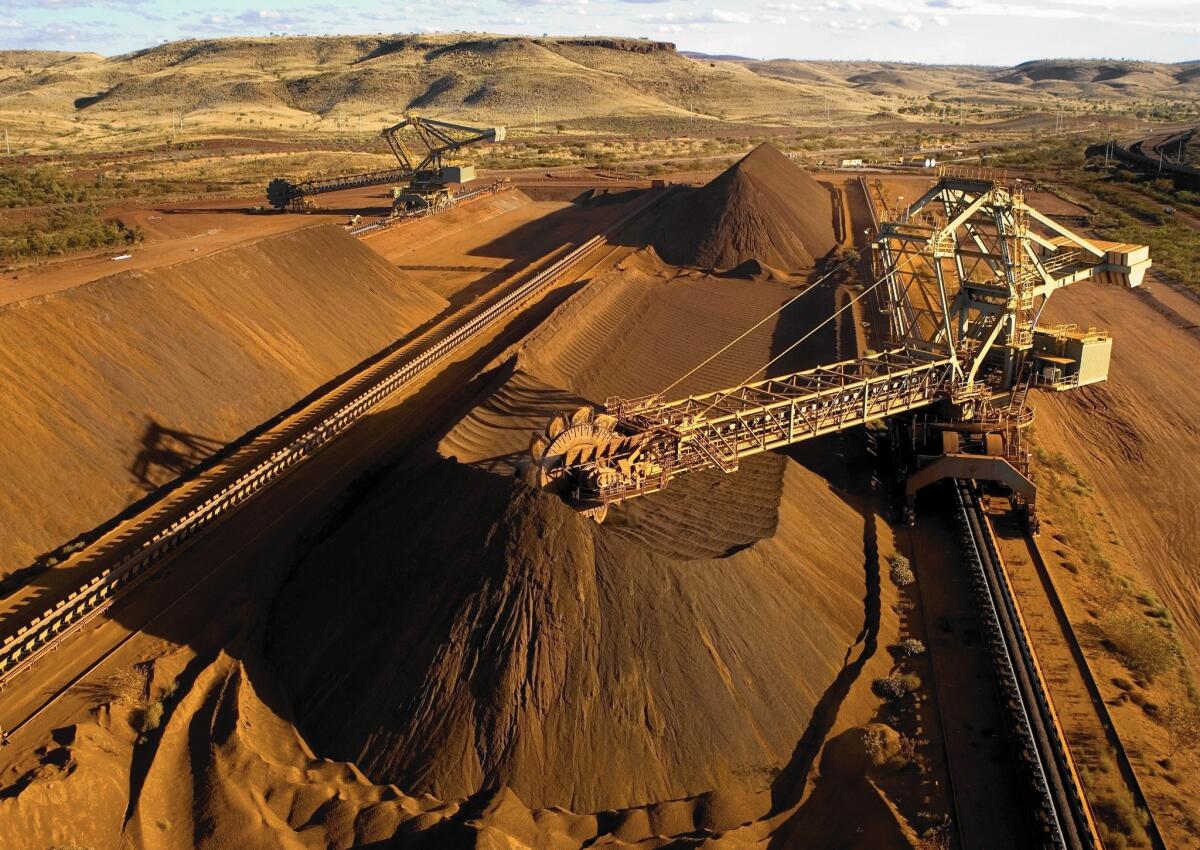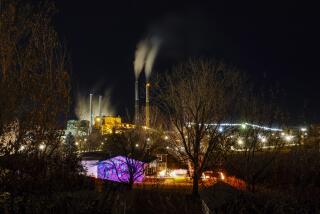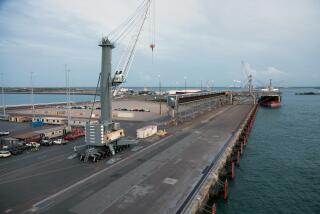Western Australia’s mining boom ebbs along with China’s economy

- Share via
Reporting From KARRATHA, Australia — Joe Norton, a large man with a sun-burnt face, digs into a plate full of beef, potatoes, carrots and Brussels sprouts at Searipple, a mobile-home camp in Australia’s western frontier.
It isn’t the tastiest food in the world, the 54-year-old says, but it’s free, provided by his employer, iron mining giant Rio Tinto.
So is most everything else in his life: all his meals, a Fleetwood-manufactured house with microwave and flat-screen TV, a round-trip ticket every Friday to fly home, and not the least, his $180,000 salary.
Not bad for a man with an eighth-grade education doing semi-skilled work on railways transporting iron ore.
Yet the gig probably won’t last a lot longer, Norton reckons. Some of his fellow miners already have been sent packing as the company downsizes its contracted workforce. “They’re cleaning the fat,” he says.
With China’s slowing economic growth, one of the biggest mining booms in Australian history is over, leaving behind a trail of jobless workers and struggling local businesses in places such as Karratha, which thrived in recent years but is now at risk of becoming a ghost town.
China’s once-insatiable appetite for iron, copper and other metals led to such a surge in commodity prices that even manhole covers were stolen from streets in some countries to be sold for scrap. Exports from mineral-rich nations such as Australia soared, sending the cost of an ordinary three-bedroom home here to a million dollars.
Today, China’s weaker growth has sent government budgets reeling. Currencies once bolstered by surging investments and exports to China are tumbling. Unemployment is shooting higher.
It’s a problem around the world, from Brazil to Indonesia to South Africa. Australia, in particular, is feeling the pain.
“Australia’s economy is not the golden goose it used to be,” says Adrian Hart, a mining and infrastructure expert at BIS Shrapnel, a research and forecasting firm in Sydney.
An expected slowdown in shipments of coal and iron ore, as well as related investments, is likely to shrink tax revenue and government royalties, putting more strain on public spending.
“Now that the mining boom is over, all this virtuous cycle is turning the other way,” Hart says.
The price of iron ore slumped nearly 50% over the last year to about $70 a metric ton. Like oil, the decline in iron prices reflects a continuing increase in supply as demand slows. Rio Tinto and other mining giants have used the price slump to put the squeeze on smaller, less-efficient rivals. But they, too, may eventually feel the pinch.
Australia is the world’s largest producer of iron ore. Most of it goes to China, which accounts for about two-thirds of iron ore sales in overseas markets. But analysts are predicting a softer demand for iron in the years ahead as China tries to cool its housing and industrial production.
A similar if less dramatic scenario is playing out in Australia’s huge coal region in the east, where the boom is also over.
In Australia’s west, places such as Perth, the region’s largest city and the hub of the iron and petroleum industry, have been especially hard hit.
“A lot of people are out of work,” says Lachlan Walker, chief executive of Tetra Tech Proteus, a Perth unit of global engineering services firm Tetra Tech Inc. in Pasadena. Walker says he has halved his staff from two years ago, to about 120.
Perth is likely to ride out the mining decline, a little poorer but intact. With about 2 million people, the area is big enough to live largely off the economic power of its own residents, with plenty of jobs in government and services such as education and healthcare. Farming is helping too, particularly with the Chinese buying land in Australia to grow crops and feed its people.
It’s a little more dicey for Karratha, a wind-swept town in the vast region known as the Pilbara, where iron is its mainstay.
Close to a third of Karratha’s 35,000 residents are more or less temporary — fly-in, fly-out workers like Norton, or FIFOs, as they’re called here. They’ve come from all over the country, in many cases leaving behind families and more prestigious but less financially rewarding careers.
Norton left behind his wife, four children and a wheat farm outside Perth to be a contract miner about a decade ago. For his big salary and all the benefits, he puts in grueling days: waking up at 4 in the morning for breakfast, driving sometimes 300 miles away to repair rails and returning to camp at 6 p.m.
“I know why I’m here,” Norton says, adding that he makes sure he doesn’t drink or fool around. Stories abound of depression and marriage breakups among FIFOs. “We’re clearing debt and setting ourselves up for retiring.”
Without a larger, stable population and better infrastructure, Karratha could wither and turn into one of dozens of ghost towns that now dot Western Australia, says researcher Jemma Green of Curtin University in Perth.
She points to Cossack, just 30 miles east of Karratha, a once-promising pearling town that today is little more than a few historic buildings and a cemetery with old tombstones. Cossack shriveled shortly after the gold rush ended around the eve of the 20th century.
Some residents already have started to leave Karratha, and others are preparing to do so.
The Pilbara’s two giant iron mining companies, Rio Tinto and BHP Billiton, haven’t yet slowed production; they can still make a profit at current prices. But with new iron-mining construction fading, experts estimate that employment in the Pilbara, which has a total population of just 50,000, will shrink by 14,300 workers by 2020.
As Karratha’s mayor, Peter Long sees a lot more hope for the town. He remembers that when he arrived in 1985 there was little more than a few pubs, a supermarket and some small shops.
Today, Karratha has a performing arts center, private high school, an airport and a 60-store mall anchored by Target on one end and Kmart on the other, fruits of China’s past iron ore purchases.
Karratha isn’t just about iron or China, he says. It’s a port city with tourism and massive offshore petroleum investments. Even so, its dependence on resources means “it’s always been at the mercy of cycles, prices and projects,” says Bernard Salt, a demographer at the advisory firm KPMG’s office in Melbourne.
What’s more, it’s never been easy to attract permanent residents to this dry, remote area with extreme temperatures and small communities of aborigines.
To lure workers and keep them from being poached by mining firms, even fast-food operators and retailers paid workers $20 an hour or more, making the Pilbara one of the most expensive places in the country.
“I love it,” Belinda Meyer says of the Pilbara’s frontier life: camping, fishing, four-wheel driving through the red desert. But the 35-year-old, who moved here from Perth eight years ago with her partner, a miner, also hates it.
She complains about the summer heat, routinely over 110 degrees. There’s no bowling alley or movie theater, she says. Housing prices have come down some in the last year, but Meyer and her partner still pay $1,300 a week to rent a four-bedroom house, plus $900 a month for air conditioning in the summer.
“You can’t afford to go out,” she says, sitting with her two kids in a McDonald’s, where a plain cheeseburger costs more than triple the price in the United States. “A beer in the pub costs you a fortune.”
More to Read
Inside the business of entertainment
The Wide Shot brings you news, analysis and insights on everything from streaming wars to production — and what it all means for the future.
You may occasionally receive promotional content from the Los Angeles Times.











